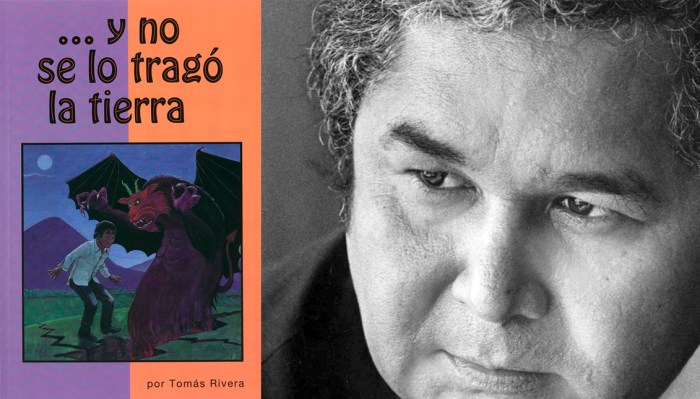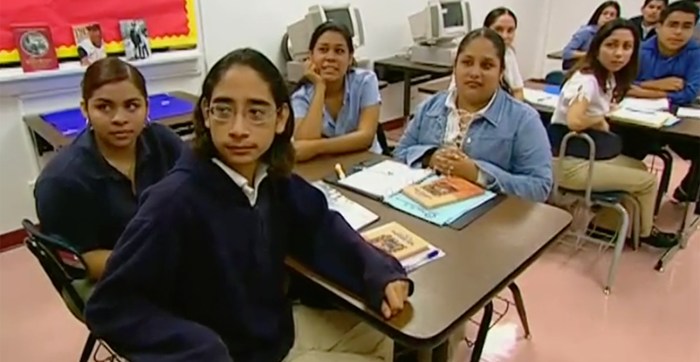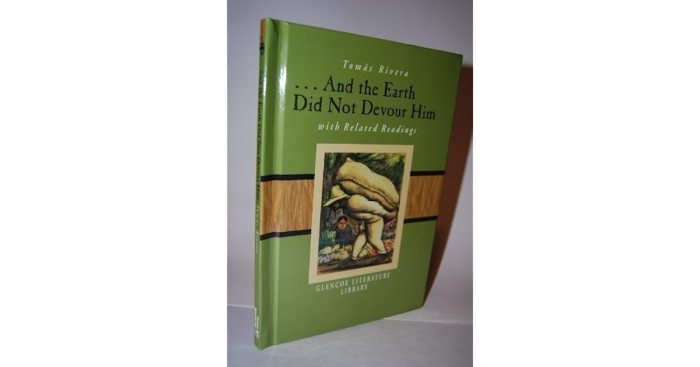Tomas rivera y no se lo trago la tierra – Tomas Rivera’s “Y No Se Lo Tragó la Tierra” stands as a towering achievement in Mexican-American literature, a poignant and evocative exploration of identity, immigration, and social justice that has left an enduring mark on the literary landscape.
Rivera’s novel, published in 1971, is a groundbreaking work that captures the struggles and aspirations of Mexican-American migrant workers in the mid-20th century. Through the interconnected stories of several characters, Rivera weaves a tapestry that reveals the complexities of Mexican-American identity and the challenges faced by those navigating two cultures.
Overview of ‘…Y No Se Lo Tragó la Tierra’

‘…Y No Se Lo Tragó la Tierra’ (1971) by Tomás Rivera is a seminal novel in Mexican-American literature. It is a powerful and evocative depiction of the struggles and triumphs of Mexican immigrants in the United States.
Rivera’s own experiences as a migrant worker and educator greatly influenced the novel. His writing reflects the complex social and cultural issues faced by Mexican-Americans in the mid-20th century.
The novel’s main themes include immigration, identity, and social justice. It follows the lives of several Mexican-American families as they navigate the challenges of life in a foreign land.
Characters and Perspectives: Tomas Rivera Y No Se Lo Trago La Tierra

Main Characters
- Don Lupe: A migrant worker who embodies the strength and resilience of the Mexican-American community.
- Doña Felipa: Don Lupe’s wife, a strong and resourceful woman who supports her family through adversity.
- El Hijo: The unnamed narrator, a young boy who witnesses the struggles and triumphs of his parents and community.
Multiple Perspectives
Rivera uses multiple perspectives to convey the diverse experiences of Mexican-Americans. The novel is narrated through the eyes of El Hijo, but it also includes the voices of other characters, including Don Lupe, Doña Felipa, and various members of the community.
This use of multiple perspectives allows Rivera to explore the complex social and cultural issues faced by Mexican-Americans from a variety of viewpoints.
Themes and Symbolism

Central Themes
- Immigration:The novel explores the challenges and opportunities faced by Mexican immigrants in the United States.
- Identity:Rivera examines the complex process of Mexican-American identity formation in a foreign land.
- Social Justice:The novel addresses issues of discrimination, poverty, and social inequality faced by Mexican-Americans.
Symbolism
Rivera uses symbolism throughout the novel to convey its themes. For example, the river that runs through the town represents the constant flow of immigrants and the challenges they face.
The title of the novel, “…Y No Se Lo Tragó la Tierra” (“…And the Earth Did Not Swallow Him”), symbolizes the resilience of the Mexican-American community despite the hardships they endure.
Historical and Cultural Context
Time Period and Setting
The novel is set in the mid-20th century in a small town in Texas. This period was a time of significant migration from Mexico to the United States.
The setting of the novel reflects the social and economic conditions faced by Mexican immigrants during this time, including poverty, discrimination, and limited opportunities.
Social and Political Issues
Rivera’s writing was influenced by the social and political issues of his time. The novel reflects the experiences of Mexican-Americans during the Civil Rights Movement and the Chicano Movement.
The novel addresses issues of racial discrimination, labor exploitation, and the struggle for social justice.
Literary Style and Techniques
Writing Style
Rivera’s writing style is characterized by its simplicity, lyricism, and evocative use of language. He employs vivid imagery and sensory details to create a powerful and immersive experience for the reader.
Rivera’s prose is often lyrical, with a rhythmic quality that reflects the oral tradition of Mexican-American storytelling.
Literary Devices
Rivera uses a variety of literary devices to convey his themes and create a vivid and memorable narrative.
- Imagery:Rivera uses vivid imagery to create a strong sensory experience for the reader, evoking the sights, sounds, and smells of the Mexican-American community.
- Metaphor:Rivera uses metaphors to create deeper meaning and connections within the text, comparing different elements to illuminate their similarities and differences.
- Foreshadowing:Rivera uses foreshadowing to hint at future events and create a sense of anticipation and suspense.
Structure
The novel is structured in a non-linear fashion, moving between different time periods and perspectives. This structure reflects the fragmented nature of the Mexican-American experience.
The novel’s episodic structure allows Rivera to explore different aspects of the Mexican-American community and their struggles.
Critical Reception and Legacy
Critical Reception, Tomas rivera y no se lo trago la tierra
Upon its release, ‘…Y No Se Lo Tragó la Tierra’ received critical acclaim for its powerful and evocative depiction of the Mexican-American experience.
The novel was praised for its lyrical writing style, its exploration of complex social issues, and its authentic portrayal of Mexican-American characters.
Legacy
‘…Y No Se Lo Tragó la Tierra’ has had a lasting impact on Mexican-American literature and beyond.
- Mexican-American Literature:The novel is considered a foundational text in Mexican-American literature, helping to establish its place in American literature.
- Social Justice:The novel’s exploration of social justice issues has resonated with readers from diverse backgrounds, highlighting the universal struggles for equality and dignity.
- Continuing Relevance:The novel remains relevant today, as it continues to speak to the experiences of immigrants and marginalized communities.
Clarifying Questions
What is the significance of “Y No Se Lo Tragó la Tierra” in Mexican-American literature?
It is a seminal work that broke ground in representing the experiences and perspectives of Mexican-American migrant workers, giving voice to a marginalized community.
Who is Tomas Rivera?
Tomas Rivera was a Mexican-American author, poet, and educator who is considered one of the pioneers of Chicano literature.
What are the main themes explored in “Y No Se Lo Tragó la Tierra”?
The novel explores themes of immigration, identity, social justice, and the struggles faced by Mexican-Americans in the mid-20th century.